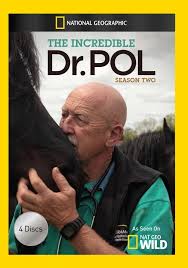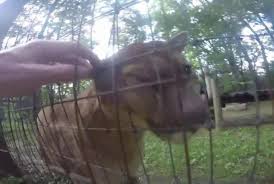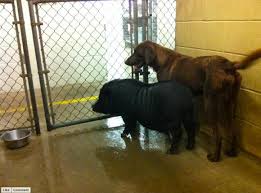The Incredible Dr. Pol
Dr. Jan Pol
 Nat Geo Wild's Dr. Pol returns to Animal Radio® Airwaves with stories from his intriguing life. He'll talk about how surreal it is to see his face on comic books and a gaming app.
Nat Geo Wild's Dr. Pol returns to Animal Radio® Airwaves with stories from his intriguing life. He'll talk about how surreal it is to see his face on comic books and a gaming app.
Since his last appearance, Dr. Pol has appeared in a comic strip and even has his own game app. He has also written a book, "Never Turn Your Back On An Angus Cow."
Dr. Pol states that if you ever do turn your back on an Angus cow, "They'll get ya!" This has happened to him many times. He goes on to state that if you turn your back on any animal, they will attack you. But an Angus cow, especially one with a calf, "Well, you had better be close to a fence or she'll take care of you in no time flat!
The free app, "Dr. Pol Vet Rescue Game," which Dr. Pol played once, is great game for children, where they can rescue animals in distress. And when asked what he thought about seeing his face on a comic book, he states, "I think it's amazing. I never thought anything like this would happen."
When Dr. Pol's son originally approached him about doing reality show on his practice, Dr. Pol didn't think anyone would want to watch him. To date, they have now filmed 8 seasons of "The Incredible Dr. Pol," which follows the doctor on his routine 14-hour workdays treating both pets and livestock.
Being born and raised on a dairy farm, Dr. Pol is particular to the larger animals, especially the bovine and equine. He does like small animals, because it allows him to do so much more. Smaller animals have a lot more diseases, which allows him to do more types of surgeries.
He also talks about farm animals, especially among the Amish, which are "tools." For farmers, a cow is a source of income, and when you cannot bring that cow back to production, then you have to think about what you need to do and whether or not it is worth it to the farmer, and what they're willing to spend. This is much different than what people will do for their pets.
Visit Website
America Has Two Nasty Little Secrets
Kim Sill, Saved In America
 Actress Kim Sill took a camera and went undercover to show America the two biggest and nastiest lies about the pet welfare industry. She'll explain where pet stores get their animals and what the big welfare agencies, like the ASPCA, HSUS, AHA and Best Friends, do with your donations.
Actress Kim Sill took a camera and went undercover to show America the two biggest and nastiest lies about the pet welfare industry. She'll explain where pet stores get their animals and what the big welfare agencies, like the ASPCA, HSUS, AHA and Best Friends, do with your donations.
America has two nasty little secrets and those secrets are:
1. All of those cute puppies that are sold in pet stores come from "puppy mills." Their mothers spend their entire lives in tiny, unsanitary cages, never walked, never petted, never doing anything but making puppies.
2. Most Americans would rather look the other way than to see what is happening in the animal rescue world.
Saved In America is the story of one woman's journey to show America what is happening in the animal welfare world. Kim Sill protested for an entire year to bring awareness about pet shops selling puppy mill dogs. What she found was shocking and led her to ask why half a billion dollars a year is raised in the name of animal welfare and the grassroots rescues in America's communities are not seeing any of this money?
The movie contains undercover footage as well as footage of when Kim was protesting those pet shops that are selling mass-produced dogs.
Kim decided to put the film out there because when she put the footage together, she realized that many people don't know what goes on with these puppies and how their parents are kept. The parents are being used for mass productions of puppies, with so many of them literally never seeing the light of day. They normally spend their entire lives in cages that are stacked upon each other.
 This is the story of the underdogs and the everyday heroes who spend their time and money rescuing animals. Kim met many people on her journey including Pink. Cesar Millan, "Dr. Phil," Kim Kardashian, and Katherine Heigl who all make appearances in the film to help raise awareness about America's homeless pet population. Thousands of animals are saved along Kim Sill's way as she documents and films her way through the rescue world of hoarders, animal abusers, gangs and puppy mills.
This is the story of the underdogs and the everyday heroes who spend their time and money rescuing animals. Kim met many people on her journey including Pink. Cesar Millan, "Dr. Phil," Kim Kardashian, and Katherine Heigl who all make appearances in the film to help raise awareness about America's homeless pet population. Thousands of animals are saved along Kim Sill's way as she documents and films her way through the rescue world of hoarders, animal abusers, gangs and puppy mills.
To help animals, you should donate to your local shelter where the money will go directly to help the animals. Forget about these large organizations that run million dollar television ads requesting donations, as your money is going to pay for these ads as well as the t-shirts, hats, etc. that you receive when you send in a donation. The money is NOT going to the animals, as it cots money for commercials and promotional items. When you send in $20 to these large organizations, they then use that money to send out more solicitations for money, and to pay themselves large salaries.
Visit Website
JFK Building Animal Terminal
Doc Halligan, Lucy Pet Foundation
 JFK Airport broke ground on a new 48 million dollar terminal specifically for animals. It'll boast a canine hotel where you can board your dog. Doc Halligan has the latest on the 178,000 square foot facility.
JFK Airport broke ground on a new 48 million dollar terminal specifically for animals. It'll boast a canine hotel where you can board your dog. Doc Halligan has the latest on the 178,000 square foot facility.
Doc Halligan recently spoke with Dr. Aaron Perl, who is the Managing Director of the ARK. Dr. Aaron Perl, who is both a lawyer and a doctor, states that they just broke construction on the ARK at New York's John F. Kennedy International Airport, which should be opened by this time next year.
The ARK is a comprehensive multi-purpose animal handling and air cargo facility. It will be located in a 178,000 square foot terminal, which was currently not being used. It is expected to cost $54 million dollars to complete. It is intended to act as a quarantine and boarding facility and is actually going to be a sort of luxury hotel for animals. This will be a state of the art facility and there has never been anything like this before. They will be able to handle every kind of animal imaginable.
JFK (New York's John F. Kennedy International Airport) and LAX (California's Los Angeles International Airport) are two of the largest airports that handle animal traffic. You name it, horses, aardvarks, chickens; all types of animals have passed through these airports.
There are regulations when animals come to this country and they may even be required to be quarantined for a period of time. This new facility will make it safer for the animals, and the public, because thee animals can be easily screened for any possible diseases coming into our country. If they are quarantined, horses and cattle will now stay in comfortable hay-lined stalls, there will also be pens for goats, pigs, sheep, etc., as well as an aviary for birds.
 The ARK will also handle domestic animals, with a 20,000 square foot luxury resort, with bone-shaped pools, air-conditioned rooms, TVs and even a boarding facility for overnight stays, costing upward to $100 per night.
The ARK will also handle domestic animals, with a 20,000 square foot luxury resort, with bone-shaped pools, air-conditioned rooms, TVs and even a boarding facility for overnight stays, costing upward to $100 per night.
The ARK is working closely with the Cornell Veterinary School during the planning stages. Who better to consult with, as veterinarians are the experts when it comes to animals! Some people are criticizing the amount of money that is being spent on this facility, but animals truly enrich our lives. This will also help when transferring animals to different places around the country to ensure species survival.
Hopefully this will only be the beginning and more airports will continue to accommodate animals as more and more pets are traveling.
Visit Website
It's Not Doggie Asthma - It's a Reverse Sneeze - Dr. Debbie
 What dog owner hasn't heard that frightening sound that dogs make - part cough, part sneeze and often described as a dog being unable to catch his breath. But it really isn't asthma, or some kind of bone stuck in your dog's throat - it's a reverse sneeze. So before you panic and run into the veterinary office on emergency, ensure you know what a reverse sneeze is.
What dog owner hasn't heard that frightening sound that dogs make - part cough, part sneeze and often described as a dog being unable to catch his breath. But it really isn't asthma, or some kind of bone stuck in your dog's throat - it's a reverse sneeze. So before you panic and run into the veterinary office on emergency, ensure you know what a reverse sneeze is.
Meet the Reverse Sneeze
A reverse sneeze is a respiratory sound in a category all its own. Also known as a pharyngeal gag reflex or backwards sneeze, the reverse sneeze is a commonly observed respiratory sound in dogs, and less commonly in cats. While a true sneeze occurs on the exhale, the reverse sneeze occurs as the dog inhales. The result is a reverberating snorting, wheezing, episodic sound that lasts for a few seconds to a minute or two. A reverse sneeze is a completely harmless sound and dogs do not suffer any immediate health threat from these episodes.
How can you tell it's a reverse sneeze?
There is no easy explanation of the sound - you just have to hear it and you'll recognize it. Click to see and hear an example of a dog's reverse sneeze episode.
Part of my enjoyment on the weekly national radio program, Animal Radio®, is describing the peculiar smells, sounds and essences of veterinary medicine with our listeners. On many an occasion when speaking to callers, I have re-created the sounds of reverse sneezing. I'm no Rich Little, but I do take pride in my impersonation of a canine reverse sneeze, which is admittedly better in person with the visuals to complement the throaty sound.
Characteristics of a dog displaying a reverse sneeze include:
- Vibrational coughing/wheezing sound
- Stiff, extended neck
- Facial grimace
- No discharge from nose
- Not followed by coughing or vomiting up material
- Not involving collapse episodes
- Animal is completely normal after event
What causes a reverse sneeze?
Some reverse sneeze episodes occur when a dog gets very excited or pulls against a leash. Brachycephalic breeds (short faced breeds) like Pugs and Boston terriers commonly display reverse sneezing due to their upper airway conformation.
 Allergies, respiratory infections, nasal mites, inhaled foreign bodies and masses can also trigger reverse sneezing. Dogs with inflammatory conditions such as lymphoplasmacytic rhinitis can also display bouts of reverse sneezing. And sometimes reverse sneezing occurs in the wee hours of the night, while a dog is sleeping, for no apparent reason. In fact, many veterinarians receive panicked phone calls at 2am from pet owners, concerned of impending asthma attacks or respiratory arrest, only to have it turn out just to be a typical case of reverse sneezing.
Allergies, respiratory infections, nasal mites, inhaled foreign bodies and masses can also trigger reverse sneezing. Dogs with inflammatory conditions such as lymphoplasmacytic rhinitis can also display bouts of reverse sneezing. And sometimes reverse sneezing occurs in the wee hours of the night, while a dog is sleeping, for no apparent reason. In fact, many veterinarians receive panicked phone calls at 2am from pet owners, concerned of impending asthma attacks or respiratory arrest, only to have it turn out just to be a typical case of reverse sneezing.
What to Do?
There is no required treatment for a reverse sneeze episode. However, I recommend stroking a dog's throat while gently speaking to him in a calm manner until the episode subsides. Some advocate closing/pinching the nostrils off, which forces a dog to swallow and curtails the reverse sneeze episode. Whatever the approach, reverse sneezing episodes are over within minutes, so no emergency treatment is indicated. Antihistamines may be prescribed to minimize reverse sneezing episodes.
When to Worry?
If all of a sudden your dog is having repeated bouts of reverse sneezing, evaluation by your veterinarian is indicated. Consult with your veterinarian if your dog is reverse sneezing along with other symptoms such as facial rubbing, nasal bleeding, nasal discharge, coughing, or significant sneezing episodes.
Nasal mites are a common cause of reverse sneezing and may be noted after a recent boarding visit, especially if multiple dogs in a household are involved. Nasal mite treatment is easily pursued with anti-parasite injections of ivermectin (or in collie breeds - the alternative Milbemycin.) If reverse sneezing is excessive and prolonged, the nasal and pharyngeal areas should be evaluated by a veterinarian through rhinoscopy - a procedure performed under anesthesia in which the nasal passages and pharyngeal areas are visualized with an endoscope, a micro camera. This is how foreign objects and masses are typically identified. In other cases, further tests may be needed including a CT scan or with biopsy samples from sinus passages.
Final Thought
The good news is that most of reverse sneezing episodes are harmless, and do not indicate any serious illness. Arm yourself with information by learning what a reverse sneeze looks like and you may save yourself an unwanted emergency veterinary visit over this peculiar but non-life threatening occurrence.
Featured veterinarian known as "Dr. Debbie" on national pet radio program, Animal Radio. Ebook author of "Yorkshire Terriers: How to Be Your Dog's Best Friend"; "Pugs: How to Be Your Dog's Best Friend"; "Mini Schnauzers: How to Be Your Dog's Best Friend"; and "Shih Tzu: How to Be Your Dog's Best Friend." Dr. Debbie's books.
Visit Website
Animal Radio News - Lori Brooks
 Crash Test Dogs Test Crates & Carriers
Crash Test Dogs Test Crates & Carriers
The latest crash test research on pet carriers and crates has been released. The Center for Pet Safety and Subaru worked together with a NASA engineer to create specially designed crash test dog dummies for the study. 14 products in all were tested and the three that performed the best and safest for your pet to ride in while traveling are: 1. Gunner Kennels G1 Intermediate; 2. Pet Ego Forma Frame Jet Set Carrier; and 3. Sleepy-Pod Mobile Pet Bed with Handilock. The researchers said some of the crates and carriers were not travel worthy at all. It's so great that this research is being done now because unlike consumer products for people, these pet products are not regulated.
Dr. Seuss Book, "What Pet Should I Get?" Recently Released
Dr. Seuss may have died back in 1991, but thanks to an assistant of his who a few years ago found a previously unpublished book he wrote, that book has now been released. It's called "What Pet Should I Get?" and was in such demand that a whopping 1 million hardcover copies were printed for the first edition. The book is believed to have been written between 1958 and 1962, and back then we spoke about pets and animals differently. So Seuss' script was tweaked to encourage people to adopt, rather than buy, pets.
 Man Climbs Fence to Pet Cougars At Zoo
Man Climbs Fence to Pet Cougars At Zoo
Zoo officials in Ohio say they are pressing charges against a man who jumped a fence to pet cougars, then posted a video of the stunt on YouTube that shows two cougars being petted through a fence as the 35-year-old man says things such as "Kitty, kitty, kitty." The Columbus Zoo and Aquarium says he's been charged with a misdemeanor count of trespassing.
New Regulations For Pet Store Puppies
Pet stores that sell puppy mill dogs, and other pets that make profits for them through terrible breeding and kennel conditions, are being put out of business as the industry and it's cruelty is exposed. However, there's a new kind of pet store popping up, as they have to adhere to new laws and regulations. For example, in Illinois some cities have enacted laws where pet storeowners must include with their disclosures to prospective customers actual pictures of the mother of the pet for sale as well as the facility where the animal was born and raised and the number of animals kept by that kennel. Penalties for violations of the ordinance can be up to $1,000 for the first offense.
 Shelters Overcrowded With Pigs
Shelters Overcrowded With Pigs
Pet shelters are being overcrowded in many cases these days by dogs and cats, but also pigs who are sold by unscrupulous breeders who tell clients the pigs are mini pigs. In one case, a woman who bought a so-called mini pig fed it what the breeder instructed: a half-cup of food in the morning and a half-cup at night. The breeder promised the diet would keep the pig at only 12 inches tall. But the piglet named Hammond started raiding the pantry and digging through the trash. Veterinarians told the woman that Hammond was behaving badly because he was starving. It's a common story that's happening all around the county, leaving thousands of pet pigs homeless and rescues packed. The crunch has led many sanctuaries to limit how many pigs they will accept or stop taking them completely. One pet pig sanctuary in California says they get 20 calls a day from people trying to get rid of their pigs. The real sad part is that the North American Potbellied Pig Association estimates that 90-percent percent of pigs adopted in the U.S. are later taken to a rescue or sanctuary.
 Listen to the entire Podcast of this show (#1065)
Listen to the entire Podcast of this show (#1065)





